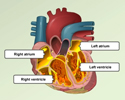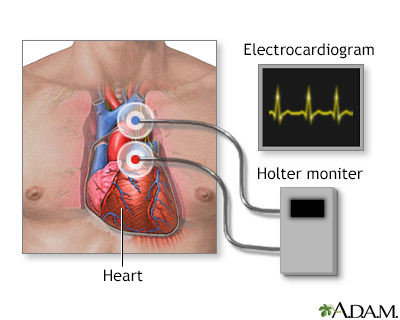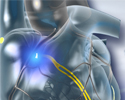Paroxysmal supraventricular tachycardia (PSVT)
PSVT; Supraventricular tachycardia; Abnormal heart rhythm - PSVT; Arrhythmia - PSVT; Rapid heart rate - PSVT; Fast heart rate - PSVTParoxysmal supraventricular tachycardia (PSVT) is episodes of a rapid heart rate that start in a part of the heart above the ventricles. "Paroxysmal" means from time to time.
Rapid heart rate
A bounding pulse is a strong throbbing felt over one of the arteries in the body. It is due to a forceful heartbeat.

Causes
Normally, the chambers of the heart (atria and ventricles) contract in a coordinated manner.
- The contractions are caused by an electrical signal that begins in an area of the heart called the sinoatrial node (also called the sinus node or SA node).
- The signal moves through the upper heart chambers (the atria) and tells the atria to contract.
- After this, the signal moves down in the heart and tells the lower chambers (the ventricles) to contract.
The intrinsic conduction system sets the basic rhythm of the beating heart by generating impulses which stimulate the heart to contract.
The rapid heart rate from PSVT may start with events that occur in areas of the heart above the lower chambers (ventricles).
There are a number of specific causes of PSVT. It can develop when doses of the heart medicine, digitalis, are too high. It can also occur with a condition known as Wolff-Parkinson-White syndrome, which often causes symptoms in young people and infants.
Wolff-Parkinson-White syndrome
Wolff-Parkinson-White (WPW) syndrome is a condition in which there is an extra electrical pathway in the heart that leads to periods of rapid heart r...

The following increase your risk for PSVT:
- Alcohol use
Alcohol use
Alcohol use involves drinking beer, wine, or hard liquor.
Read Article Now Book Mark Article - Caffeine use
Caffeine
Caffeine is a substance that is found in certain plants. It can also be man-made and added to foods. It is a central nervous system stimulant and a...
Read Article Now Book Mark Article - Illicit stimulant drug use
- Smoking
Symptoms
Symptoms most often start and stop suddenly. They can last for a few minutes or several hours. Symptoms may include:
- Anxiety
Anxiety
Stress is a feeling of emotional or physical tension. It can come from any event or thought that makes you feel frustrated, angry, or nervous. Stres...
 ImageRead Article Now Book Mark Article
ImageRead Article Now Book Mark Article - Chest tightness
- Palpitations (a sensation of feeling the heartbeat), often with an irregular or fast rate (racing)
Palpitations
Palpitations are feelings or sensations that your heart is pounding or racing. They can be felt in your chest, throat, or neck. You may:Have an unpl...
 ImageRead Article Now Book Mark Article
ImageRead Article Now Book Mark Article - Rapid pulse
Rapid pulse
A bounding pulse is a strong throbbing felt over one of the arteries in the body. It is due to a forceful heartbeat.
 ImageRead Article Now Book Mark Article
ImageRead Article Now Book Mark Article - Shortness of breath
Shortness of breath
Breathing difficulty may involve:Difficult breathing Uncomfortable breathingFeeling like you are not getting enough air
 ImageRead Article Now Book Mark Article
ImageRead Article Now Book Mark Article
Other symptoms that can occur with this condition include:
- Dizziness
Dizziness
Dizziness is a term that is often used to describe 2 different symptoms: lightheadedness and vertigo. Lightheadedness is a feeling that you might fai...
 ImageRead Article Now Book Mark Article
ImageRead Article Now Book Mark Article - Fainting
Fainting
Fainting is a brief loss of consciousness due to a drop in blood flow to the brain. The episode most often lasts less than a couple of minutes and y...
Read Article Now Book Mark Article
Exams and Tests
A physical exam during a PSVT episode will show a rapid heart rate. It may also show forceful pulses in the neck.
The heart rate may be over 100, and even more than 250 beats per minute (bpm). In children, the heart rate tends to be very high. There may be signs of poor blood circulation such as lightheadedness. Between episodes of PSVT, the heart rate is normal (60 to 100 bpm).
An electrocardiogram (ECG) during symptoms shows PSVT. An electrophysiology study (EPS) may be needed for an accurate diagnosis and to find the best treatment.
Electrocardiogram
An electrocardiogram (ECG) is a test that records the electrical activity of the heart.

Electrophysiology study
Intracardiac electrophysiology study (EPS) is a test to look at how well the heart's electrical signals are working. It is used to evaluate abnormal...

Because PSVT comes and goes, to diagnose it people may need to wear a 24-hour Holter monitor. For longer periods of time, another type of the rhythm recording device may be used.
Holter monitor
A Holter monitor is a machine that continuously records the heart's rhythms. The monitor is worn for 24 to 48 hours during normal activity.

During a heart Holter monitor study, the patient wears a monitor that records electrical activity of their heart (similarly to the recording of an electrocardiogram). This usually occurs for 24 hours, while at the same time the patient also records a diary of their activity. Health care providers then analyze the recording, tabulate a report of the heart's activity, and correlate irregular heart activity with the entries of the patient's diary.
Treatment
PSVT that occurs only once in a while may not need treatment if you don't have symptoms or other heart problems.
You can try the following techniques to interrupt a fast heartbeat during an episode of PSVT:
- Valsalva maneuver. To do this, you hold your breath and strain, as if you were trying to have a bowel movement.
- Coughing while sitting with your upper body bent forward.
- Splashing ice water on your face
You should avoid smoking, caffeine, alcohol, and illicit drugs.
Emergency treatment to slow the heartbeat back to normal may include:
- Electrical cardioversion, the use of electric shock
Cardioversion
Cardioversion is a method to bring an abnormal heart rhythm back to normal.
 ImageRead Article Now Book Mark Article
ImageRead Article Now Book Mark Article - Medicines through a vein
Long-term treatment for people who have repeat episodes of PSVT, or who also have heart disease, may include:
- Cardiac ablation, a procedure used to destroy small areas in your heart that may be causing the rapid heartbeat (currently the treatment of choice for most PSVTs)
Cardiac ablation
Cardiac ablation is a procedure that is used to scar small areas in your heart that may be involved in your heart rhythm problems. This can prevent ...
Read Article Now Book Mark Article - Daily medicines to prevent repeat episodes
- Pacemakers to override the fast heartbeat (on occasion may be used in children with PSVT who have not responded to any other treatment)
Pacemakers
A pacemaker is a small, battery-operated device. This device senses when your heart is beating too slowly. It sends a signal to your heart that mak...
 ImageRead Article Now Book Mark Article
ImageRead Article Now Book Mark Article - Surgery to change the pathways in the heart that send electrical signals (this may be recommended in some cases for people who need heart surgery for other reasons)
Outlook (Prognosis)
PSVT is generally not life threatening. If other heart disorders are present, it can lead to congestive heart failure or angina.
Congestive heart failure
Heart failure is a condition in which the heart is no longer able to pump oxygen-rich blood to the rest of the body efficiently. This causes symptom...

When to Contact a Medical Professional
Contact your health care provider if:
- You have a sensation that your heart is beating quickly and the symptoms do not end on their own in a few minutes.
- You have a history of PSVT and an episode does not go away with the Valsalva maneuver or by coughing.
- You have other symptoms with the rapid heart rate.
- Symptoms return often.
- New symptoms develop.
It is especially important to contact your provider if you also have other heart problems.
References
Dalal AS, Van Hare GF. Disturbances of rate and rhythm of the heart. In: Kliegman RM, St. Geme JW, Blum NJ, Shah SS, Tasker RC, Wilson KM, eds. Nelson Textbook of Pediatrics. 21st ed. Philadelphia, PA: Elsevier; 2020:chap 462.
Kalman JM, Sanders P. Supraventricular tachycardias. In: Libby P, Bonow RO, Mann DL, Tomaselli GF, Bhatt DL, Solomon SD, eds. Braunwald's Heart Disease: A Textbook of Cardiovascular Medicine. 12th ed. Philadelphia, PA: Elsevier; 2022:chap 65.
Page RL, Joglar JA, Caldwell MA, et al. 2015 ACC/AHA/ HRS guideline for the management of adult patients with supraventricular tachycardia: a report of the American College of Cardiology/American Heart Association Task Force on Clinical Practice Guidelines and the Heart Rhythm Society. Circulation. 2016;133(14);e471-e505. PMID: 26399662 pubmed.ncbi.nlm.nih.gov/26399662/.
Zimetbaum P, Goldman L. Supraventricular ectopy and tachyarrhythmias. In: Goldman L, Cooney KA, eds. Goldman-Cecil Medicine. 27th ed. Philadelphia, PA: Elsevier; 2024:chap 52.
What makes your heart beat?
Animation
The intrinsic conduction system sets the basic rhythm of the beating heart by generating impulses which stimulate the heart to contract.
Conduction system of the heart
illustration
During a heart Holter monitor study, the patient wears a monitor that records electrical activity of their heart (similarly to the recording of an electrocardiogram). This usually occurs for 24 hours, while at the same time the patient also records a diary of their activity. Health care providers then analyze the recording, tabulate a report of the heart's activity, and correlate irregular heart activity with the entries of the patient's diary.
Holter heart monitor
illustration
The intrinsic conduction system sets the basic rhythm of the beating heart by generating impulses which stimulate the heart to contract.
Conduction system of the heart
illustration
During a heart Holter monitor study, the patient wears a monitor that records electrical activity of their heart (similarly to the recording of an electrocardiogram). This usually occurs for 24 hours, while at the same time the patient also records a diary of their activity. Health care providers then analyze the recording, tabulate a report of the heart's activity, and correlate irregular heart activity with the entries of the patient's diary.
Holter heart monitor
illustration
Review Date: 2/27/2024
Reviewed By: Thomas S. Metkus, MD, Assistant Professor of Medicine and Surgery, Johns Hopkins University School of Medicine, Baltimore, MD. Also reviewed by David C. Dugdale, MD, Medical Director, Brenda Conaway, Editorial Director, and the A.D.A.M. Editorial team.






